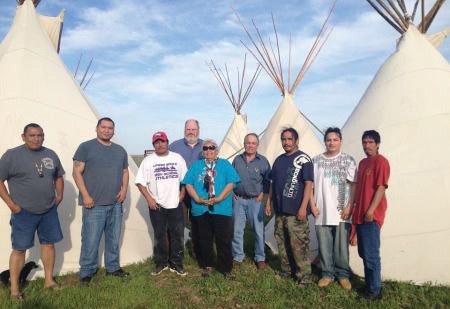
Dakota Rural Action President Paul Seamans (right of center) and Executive Director Frank James (back) are flanked by spiritual camp denizens. Photo Courtesy DRA
Tipi camps opposed to XL Pipeline host ‘day of unity’
By Talli Nauman
Native Sun News
Health & Environment Editor BRIDGER –– Spiritual camps and allies are inviting the public to join them June 21 for “a day of unity and action in South Dakota against the Keystone XL Pipeline.” The Calgary-based TransCanada Corp. wants to build the pipeline from Alberta Province through Lakota Territory treaty lands to carry tar-sands slurry to the Gulf Coast for refining and export. “Join us on June 21 at the spiritual camps to build relationships in South Dakota with our partners against Keystone XL,” Dakota Rural Action said in releasing a poster advertising the occasion that coincides with World Peace and Prayer Day. Organizers are calling the event Wikotawacin Omniciye, “Bringing Good Thoughts Together.” The Pte Ospaye Spiritual Camp in Bridger, Wiconi Un Tipi Spiritual Camp in Lower Brule, and Oyate Wahacanka Woecun Spiritual Camp in Ideal are celebrating the day with meetings and activities. Allies include Dakota Rural Action and the Brave Heart Society. Dakota Rural Action President Paul Seamans said that tribal activists first invited members of his statewide family-farm organization to attend meetings and resist the Keystone XL Pipeline more than three years ago. "Since that time DRA has formed close relationships with many tribal members, and we feel it important to maintain these friendships as they are important to the work that we both are doing,” Seamans told the Native Sun News. “During the Day of Unity, some of our members are planning on visiting the spirit camps and strengthen these friendships and alliances,” said Seamans, whose ranchland is on the proposed pipeline route. “We have a lot of the same concerns, it just seems logical to work together on them," he said. Calgary-based TransCanada Corp. has built the southern portion of 1,375-mile pipeline. Tribal activists have constructed the spiritual tipi encampments on the route to challenge its completion through ancestral lands in Nebraska, South Dakota, and Montana. The U.S State Department must decide whether the proposal is in the national interest, because TransCanada Corp. has requested a Presidential Permit to run the pipeline across the Canada-U.S. border. Under pressure to approve the permit from Canadian Prime Minister Stephen Harper and congressional delegates in the United States, President Barack Obama has formally declined to make a decision on three occasions to date. Another Keystone XL permit, the South Dakota Public Utilities’ construction license, will expire at the end of the month of June, forcing TransCanada Corp. to certify that its project continues to meet the conditions upon which it was granted in 2010. Dakota Rural Action has announced plans to object to a permit extension. “We will be right there, ready to intervene, along with our allies and partners in the fight against Keystone XL,” DRA said in a written statement. Seamans was among the parties who intervened in the initial permitting process. At the time, TransCanada already had built the Keystone I Pipeline through North Dakota and all the counties on the eastern border of South Dakota. The line experienced more than a dozen toxic spills in as many months. “The first Keystone project had been built with little or no attention paid to it and the outlook was similar for the newly proposed Keystone XL,” DRA said. The non-profit helped landowners organize along the route of the second proposed line. “At the first meeting discussing the proposed pipeline, in Reva, South Dakota landowners were faced with a bleak future,” DRA staffer Sabrina King recalls. “One of the members attending the meeting said, if during the course of this debate we could make the President have to address this issue in front of the nation, we might have a chance to get a good decision,” she said. Subsequently tribal governments and organizations, together with DRA, participated in actions on Capitol Hill, the most recent being an April protest demonstration on the National Mall by the Cowboy and Indian Alliance. Landowners who negotiated easements with TransCanada Corp. for Keystone XL had to swear they would not release the terms of their agreements. However, the final negotiated easements are a matter of public record and available at courthouses in the counties that the pipeline would go through. According to DRA, the final easement offers were lacking in many areas. “During negotiations, TransCanada had unfair leverage due to the looming threat of eminent domain,” the organization claims. “Unfortunately, when landowners were faced with the prospect of being taken through condemnation proceedings, most ended up reluctantly signing on,” King said. The one DRA member who decided the threat was too large refused to sign a deal with TransCanada Corp. and is facing eminent domain proceedings. (Contact Talli Nauman at talli.nauman@gmail.com) Copyright permission Native Sun News
Join the Conversation
